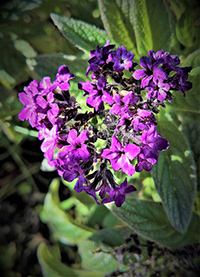Table of Contents
The leaves of the heliotrope plant follow the sun in the sky. Hence, some of its common names. The great Greek physician, pharmacologist, botanist, and author Pedanius Dioscorides recommended it to eliminate warts in the 1st century A.D.

Heliotrope Plant Scientific Facts
- Other names: European heliotrope.
- French: Heliotrope.
- Spanish: Verrucaria, hierba de las verrugas, heliotropo europeo.
- Environment: Unfarmed lands and roadsides throughout Europe, cultivated in some gardens as ornamental plants.
- Description: Plant of the Boraginaceae family, growing up to 80 cm high, with a pleasant aroma. Its stems and leaves are covered with a fine hairy layer, and its flowers are small and grow in clusters that curve in on themselves at their tips.
- Parts of the plant used medicinally: The leaves.
Healing Properties and Indications

The whole plant contains an alkaloid, heliotropin, which gives it antiseptic, cicatrizant, febrifuge, cholagogue, and emmenagogue properties. Its most important application is for skin legions: wounds, abscesses, varicose ulcerations, rashes, and warts, though it takes many days for the plant to eliminate them.
Peruvian Heliotrope

Peruvian heliotrope (Heliotropium peruvianum L., Heliotropium arborescens L.) is highly aromatic and used as a substitute for quinine due to its febrifuge properties. It also has anti-inflammatory and antiseptic actions in cystitis (urinary bladder inflammation). It is employed as a vulnerary and wound healing plant in external applications, like European heliotrope.
How to use Heliotrope
- Infusion or decoction with 20 to 40g of leaves per liter of water. Drink up to three cups daily.
- Lotions on the affected skin area are internally used with the same infusion or decoction.
- Compresses soaked in the infusion mentioned above or decoction.
Frequently Asked Questions
I understand the basics of the heliotrope plant, but how do I prepare it for consumption?
The heliotrope plant should always be prepared with careful consideration due to the presence of pyrrolizidine alkaloids (PAs). Here are the safest methods:
External Use: Heliotrope is best utilized topically. Add an infusion (tea) as a wash or compress to affected areas.
Professional Preparations: Seek specially formulated tinctures or ointments produced by qualified herbalists who understand how to mitigate PA risks.
Are there any specific concerns when using heliotrope for wound healing?
Yes, there are a few key things to remember:
Duration: Limit external use for wound healing to short periods. Continuous or long-term application is not recommended.
Open Wounds: Avoid using heliotrope on deep or open wounds, which could increase the risk of PA absorption into the bloodstream.
Pregnancy/Breastfeeding: Do not use heliotrope during pregnancy or breastfeeding under any circumstances.
Can heliotrope be used internally in any way?
Internal use of heliotrope is not advised because of the possible toxicity of PAs. The only exception to this recommendation is when it is done under the close supervision of a skilled medical practitioner knowledgeable about botanical medicine.
What are the potential side effects of using heliotrope?
While generally considered safe for external, short-term use, be aware of potential side effects:
Skin Irritation: Certain people could have skin sensitive to certain substances. Always do a patch test before using the product on a large scale.
Liver Issues: Long-term use or ingestion of heliotrope-containing PAs can cause liver damage.
Pregnancy/Breastfeeding: Heliotrope can be harmful to a developing fetus or a nursing infant.
Are there any groups who should avoid using heliotrope?
Yes. Heliotrope should be entirely avoided by:
Pregnant or Breastfeeding Women
Individuals with Liver Conditions
Children
Anyone Taking Medications
Consult your physician, as heliotrope may interact with certain medications.
DISCLAIMER: All content on this website is presented solely for educational and informational objectives. It would be best to not rely on the information provided as a replacement for advice, diagnosis, or treatment from a qualified medical expert. If you are pregnant, nursing, or have any preexisting medical concerns, you should talk to your doctor before using any herbal or natural medicines.
REFERENCES
- George D. Pamplona-Roger, M.D. “Encyclopedia of Medicinal Plants.” George D. Pamplona-Roger, M.D. Encyclopedia of Medicinal Plants. Ed. Francesc X. Gelabert. vols. 2 San Fernando de Henares: Editorial Safeliz, 2000. 713. Print. [Heliotrope plant]
- Native American Ethnobotany Database: http://naeb.brit.org/
- Journal of Ethnopharmacology: https://www.journals.elsevier.com/journal-of-ethnopharmacology
- European Food Safety Authority (EFSA): https://www.efsa.europa.eu/en
- National Toxicology Program (NTP): https://ntp.niehs.nih.gov/
- FDA Website: https://www.fda.gov/
- Google Scholar: https://scholar.google.com/
